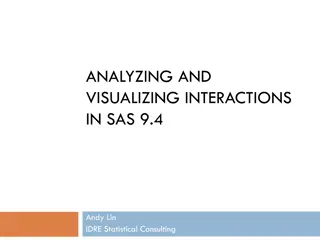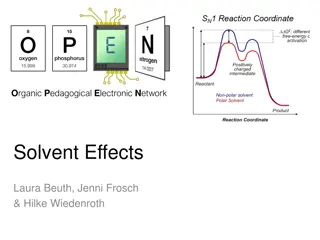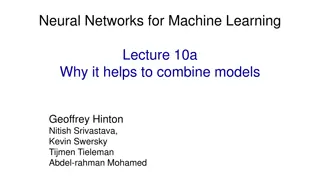Understanding Time-Varying Effects Models (TVEM) in Research
Explore the concept of Time-Varying Effects Models (TVEM) and why they are essential in analyzing interventions over time. Learn how TVEM differs from traditional regression models by incorporating time to evaluate changes in effects dynamically.
Download Presentation

Please find below an Image/Link to download the presentation.
The content on the website is provided AS IS for your information and personal use only. It may not be sold, licensed, or shared on other websites without obtaining consent from the author. Download presentation by click this link. If you encounter any issues during the download, it is possible that the publisher has removed the file from their server.
E N D
Presentation Transcript
INTRODUCTION TO TIME- VARYING EFFECTS MODELS (TVEM) Slides Courtesy of the Methodology Center at Penn State University methodology.psu.edu
Outline Conceptual Introduction to TVEM Types of Questions Data Considerations TVEM Step-by-step Research Question Data Organization Model Specification Interpretation of Output Example in Logistic TVEM
CONCEPTUAL INTRODUCTION TO TIME-VARYING EFFECT MODELING
Why TVEM? Examining effect of intervention on heavy drinking Intervention conducted to reduce alcohol abuse Post-Baseline Measurement One time point Two time points Multiple time points
Effect of Intervention: One Time Point Rate of heavy episodic drinking 0.6 Evaluating the effect of an intervention at one timepoint indicates that the intervention group decreased their HED while the placebo remained contant. 0.5 0.4 0.3 0.2 0.1 0.0 Baseline Follow-Up 1 Placebo Intervention
Effect of Intervention: Two Times Rate of heavy episodic drinking 0.6 Adding a second time point shows that the difference between placebo and intervention is getting smaller over time suggesting intervention effects may be time-varying. 0.5 0.4 0.3 0.2 0.1 0.0 Baseline Follow-Up 1 Follow-Up 2 Placebo Intervention
Effect of Intervention: Multiple Times Rate of heavy episodic drinking 0.8 0.7 Adding more followup time points further demonstrates how the intervention effect CHANGED over time but not in a way that can be captured by a linear model. 0.6 0.5 0.4 0.3 0.2 0.1 0.0 Placebo Intervention
TVEM vs Regression Regression coefficients express associations between variables Traditional regression of Y on a predictor X ?=?0+ ?1? + ? TVEM incorporates time in the regression equation. Now, we can evaluate whether and how the effects of covariates change over time ?=?0? + ?1? ? + ? TVEM allows for dynamic estimation of coefficients Natural shape of the coefficient is estimated rather than forcing the coefficient to constrain to a shape (linear, quadratic)
What is estimated? Time-Varying Association between Craving and Smoking Lapse In TVEM, we estimate regression coefficients (i.e., associations) as flexible functions of continuous time Use figure and output to interpret a coefficient function Provides 95% confidence intervals to assess significance over time Estimated coefficient 95% confidence intervals Time
Types of questions TVEM can answer Rates of Multiple Partners by Age Age (Developmental Time) Male Mean levels and associations are dynamic with age 95% CI Male Female Example: Vasilenko & Lanza (2014) Journal of Adolescent Health How does salience of risk factors for having multiple sexual partners unfold with age? 95% CI Female Proportion of individuals having sex with multiple partners by age is significantly different for men and women in late 20s.
Types of questions TVEM can answer Effect on Craving: Baseline Dependence Time from Event: Associations among variables change as function of time from event Example: Lanza et al., (2014) Nicotine and Tobacco Research How do predictors relate to craving over 14 days post-quitting cigarettes? Treatment group shows significantly weaker association between dependence and craving during second week after quit.
Types of questions TVEM can answer Historical time (years) Black Youth White Youth Levels, prevalence, and associations can change across years Example: Lanza et al, 2015, Journal of Adolescent Health Trends in substance use among U.S. high school seniors by race Black and white youth demonstrate different patterns of substance use over historical time.
Types of questions TVEM can answer Estimated Prevalence of Dependence Timing/age of onset of event Male Outcomes may differ depending on when individuals first experienced an event 95% CI Male Female Example: Lanza & Vasilenko, 2015, Addictive Behaviors Identify precise age ranges during which onset of regular smoking confers highest risk for adult nicotine dependence 95% CI Female Males Age of Onset Individuals who started smoking earlier have higher prevalence of dependence; women have higher prevalence than men at age of onset between 10 and 20.
Types of questions TVEM can answer Non-time questions: Time is in the name, but any continuous variable can be used instead of time Essentially a nuanced way of examining a continuous moderator Example: Selya et al., 2015, Addictive Behaviors Examines how associations between smoking and mood change as a function of level of nicotine dependence Nicotine dependence serves as the time variable
Data Considerations Meaningful centering/alignment point Needs to be time from some meaningful zero Potentially problematic: EMA study assessing a typical week no time anchor Coverage across the entire time span of interest Need to have all times/ages assessed near continuously Potentially problematic: Birth cohort study with data every 5 years The same measures at all waves of data collection Can be challenge in long-term longitudinal studies
Types of Data that can be used in TVEM Type 1. Cross-Sectional Type 2. Panel (repeated measures) Type 3. Intensive Longitudinal Data (ILD) Data captured from population at one specific point in time Study that involves repeated observations of same variables at 2 or more time points (waves) MANY repeated observations of the same variables (typically >20) Description of Data Participants not followed prospectively Participants only interviewed/assessed once Participants followed prospectively for two or more waves Participants followed prospectively for many assessments (not called waves) Participant Follow-up Fish et al., 2018, Prevention Science Vasilenko 2017, Developmental Psychology Cook et al., 2017, Nicotine and Tobacco Research Example Paper
Types of dependent variables in TVEM Continuous outcomes Linear model Binary outcomes Logistic model Count outcomes Poisson model Zero-inflated Poisson (count data that is drastically skewed with many zeroes) In separate TVEM ZIP macro
TVEM ANALYSIS: A STEP BY STEP EXAMPLE
Step 1: Generate a Time-Varying Research Question How does the prevalence of past-year heavy episodic drinking (HED) differ across ages 12 to age 32? How does the association between depressive symptoms and HED vary across ages 12 to age 32?
Step 2: Organize Data and Recode Variables If using longitudinal data you need a long format dataset (multiple rows per person) Recode all variables so there is one time-varying measure of each (e.g., a participants has a value on the variable at W1, W2, etc) Confirm there is adequate coverage across continuous age Create a new variable with a value of 1 for each row in the data set (for calculating intercept function)
Example Data National Longitudinal Study of Adolescent Health to Adult (Add Health; Harris, 2011) Public Use Dataset 4 waves of data collected from adolescence through adulthood Cohort sequential design (Nesselroade & Baltes, 1979) Across individuals and waves, sufficient coverage from ages 12-32 N=6,505 individuals, 21,208 measurement occasions
Recoding the Measures Data were in separate files for the four waves 4 different names for variables Recoded variables to be consistent across waves Renamed to indicate wave (e.g., dep1, dep2, dep3, dep4) Merged into a single (long) file with one variable s values at up to 4 occasions (e.g., dep) Created a variable to estimate the intercept which is equal to for all rows (i.e., a column of s)
Example Measures Outcome: Past year HED Binary variable Predictor: Depressive symptoms Continuous scale Time Variable: Age in months
Recoded Dataset Predictor: Depressive Symptoms (dep) Outcome: HED (PYBNGE) Time Variable: Age (calcage) Created Intercept Variable: (x0) Multiple Rows per Participant
Step 3: Specify model Variables in the dataset may be time-varying or time-invariant Time-invariant (don t change across chosen continuous time variable): Examples: Age first tried drinking, Race/ethnicity Time-variant (may change across continuous time): Example: current smoking status, assessed at each time Choose whether variables will have time-varying or time-invariant effects Both types of variables can be specified to have time-varying (or time-invariant) effects E.g., the effect of being male on heavy drinking may differ across age (the time-varying effect of a time-invariant variable)
Specify model: Parameters Logistic time-varying effect model (TVEM): p HED 1 p HED log = ?0? + ?1? DEP Both intercept and slope are time-varying ?0(t) indicates age-varying prevalence of the log-oddsof HED ?1(t) indicates age-varying effect of depression on the log-oddsof HED Can also add time invariant effects (none in this model)
Specify model: Splines Select B-spline or P-spline estimation method B-spline basis function More computationally stable in some cases Selects more complex model to reveal more nuanced changes Need to do model selection manually Truncated power spline basis functions (P-spline) Selects less complex model; may oversmooth curve Model selection completed automatically More information in the TVEM User s Guide
Specify model: Knots Complexity of a model is determined by the number of knots (splitting points) A number of knots needs to be selected for every time-varying effect in the model Approach varies by spline basis In b-spline, run multiple models and comparing fit statistics. In p-spline, model selection (i.e., number of knots) is done automatically. In these examples, we will show the simplest method, which is a p-spline model with a maximum of 10 knots specified for each parameter.
Step 4: Run Model Go to http://methodology.psu.edu/downloads/TVEM Download %TVEM macro and user s guide. Extract into folder Run %INCLUDE statement in SAS to point to location of macro on your computer Run LIBNAME statement in SAS to point to location of data on your computer Specify and run the TVEM model you wish to estimate
Anatomy of the Macro: Key Statements %TVEM(data = dataset name, id = variable, id: subject ID time: the continuous time variable time = variable, tvary_effect: variables to examine time- varying associations with outcome *MUST INCLUDE INTERCEPT (intercept = 1) dv = variable, dv: dependent variable tvary_effect = intercept variables, knots: the number of splitting points for each time-varying parameter dist: outcome distribution - normal, binary or poisson knots = numbers, dist = distribution name, method: P or B spline method = name);
Anatomy of the Macro: Two Sample Models Intercept Only Model Time-Varying Slope Model %TVEM(data = example, %TVEM(data = example, id = AID, id = AID, time = calcage, time = calcage, dv = pybnge, dv = pybnge, tvary_effect = x0, tvary_effect = x0 dep, knots = 10, knots = 10 10, dist = binary, dist = binary, method = p-spline); method = p-spline); Calculates the effect of depressive symptoms at every age (as well as an intercept function of HED). Calculates the estimated prevalence of HED at every age (when coefficients converted to prevalence)
Output produced by TVEM macro SAS data set ( plot data ) containing estimates of all coefficeints and corresponding 95% confidence intervals across time This information is also presented in plots to show how they change over time Can also export plot data and create plots in your preferred plotting program (e.g., SAS PROC GPLOT, Excel, R)
TVEM Output: Intercept Function Macro will produce age-varying beta plots (average level at different ages) for continuous outcomes Will produce both betas and odds for binary outcomes for intercept. Can convert to prevalence for easier interpretation
TVEM Output: Coefficient Function Macro will produce beta plots for continuous outcomes and both betas and odds ratios for binary outcomes. Odds ratios make for easier interpretations in logistic models. Effect is significant if the confidence interval does not overlap with the line at 1. Interpret like an odds ratio at each age e.g., a 1 unit increase in depressive symptoms is associated with 2.5 times greater odds of HED at age 15.
Weighted TVEM Also Available Weighted TVEM macro can incorporate weights Typically used with nationally representative data Weighted macro also useful for examining differences by subgroup without loss of sample size (See domain statement) See Weighted TVEM User s Guide for more information and Vasilenko et al., 2017, Journal of Research on Adolescence for an example.























